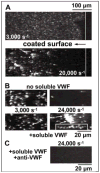The role of von Willebrand factor in thrombus formation
- PMID: 17493665
- PMCID: PMC2702526
- DOI: 10.1016/j.thromres.2007.03.011
The role of von Willebrand factor in thrombus formation
Abstract
Von Willebrand factor (VWF) is a large multimeric glycoprotein produced in endothelial cells and megakaryocytes and present in subendothelial matrix, blood plasma and platelets. VWF mediates adhesion and aggregation of platelets at sites of vascular injury, processes that are critical for both haemostasis and thrombosis. Thrombus formation involves complex events that are influenced by different environmental conditions. Progress in understanding the structure and function of VWF and the mechanisms that underlie its interactions with platelets has led to important insight into the differentiation between normal haemostasis and pathological arterial thrombosis. The conventional view of signalling-induced platelet aggregation has recently been extended to include activation-independent aggregation. A novel mechanism has been demonstrated for initiating thrombus formation under high haemodynamic forces that involves alpha(IIb)beta(3)-independent platelet aggregation at the interface between immobilised and soluble VWF. This VWF-mediated process may be a key determinant of platelet accumulation in stenotic arteries leading to acute thrombotic occlusion.
Conflict of interest statement
None declared.
Figures




References
-
- Titani K, Kumar S, Takio K, Ericsson LH, Wade RD, Ashida K, et al. Amino acid sequence of human von Willebrand factor. Biochemistry. 1986;25:3171–84. - PubMed
-
- Mendolicchio GL, Ruggeri ZM. New perspectives on von Willebrand factor functions in hemostasis and thrombosis. Semin Hematol. 2005;42:5–14. - PubMed
-
- Ruggeri ZM. Structure and function of von Willebrand factor. Thromb Haemost. 1999;82:576–84. - PubMed
Publication types
MeSH terms
Substances
Grants and funding
LinkOut - more resources
Full Text Sources
Other Literature Sources
Medical
Miscellaneous

